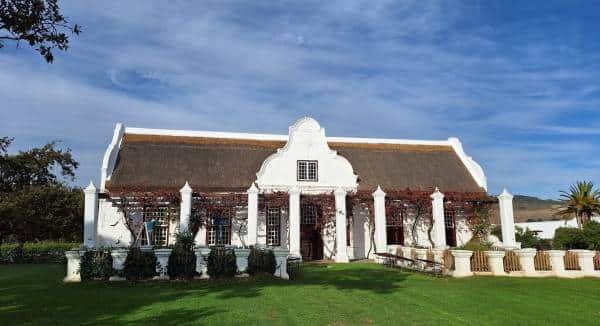
If you drive around South Africa’s premier wine-growing area in this worryingly extended autumn (and the days this week are so far positively summerish), you’ll notice an equally worrying number of dark-red vineyards. Nothing to do with lovely autumn colouring, everything to do with serious levels of virus. It looks likely that many producers in these difficult times, even in expensive, prestigious Stellenbosch, simply can’t afford to replace old vines – let alone afford to take great care of younger ones – so virus is rampant, leading to stressed vines with lower yields of grapes that can’t easily ripen. Maybe the producers are just holding on in the hope that salvation will come in the form of a property developer wanting to put up yet another housing estate, as Stellenbosch town sprawls ever wider.

Meerlust winemaker Wim Truter.
I was on Meerlust estate last week, and the story is very different there, the beautifully tended vines subsiding gracefully and greenly into winter, any virus well managed, and a programme of vineyard replacement that has been pretty continuous for at least a couple of decades now. The last five years at this great property have seen major new investment, including in uprooting and planting vines. One of the main aims is to replant in a way that “will get the best sites planted for Rubicon”, says Wim Truter. He’s been winemaker here since 2020 – his time happily coinciding with this new investment phase. Replanting has meant a temporary decline in volumes of the prime Bordeaux-style blend, but I’d guess that they’re hoping to take production more than past previous levels, while also improving the quality, especially in terms of site expression.
If you note that the latest vintage of Rubicon, 2021, retails locally for up to R600 per bottle, and that there were 126 000 bottles made, well, even I can do some basic arithmetic and conclude that Meerlust should certainly be able to afford to make some expensive investments. Indeed, and there’s no doubt also a bit of luck involved in the estate’s success – having a lovely Cape-Dutch house and werf and a family presence going back to 1756 must help marketing. And actually I think Meerlust was lucky to have had the refreshment of a new winemaker (also coinciding with new plantings) back in 2004, when Chris Williams took charge of the cellar. In the previous decade or so, Meerlust had, arguably, been drifting somewhat, and its reputation remained higher than it really deserved. But the last 20 years have seen splendid management of the business, and fully rewarded efforts in the cellar and vineyards. Hence the possibility of investment that can only continue to help it all grow. Having money undeniably helps in progress here.
Unlike the case in large swaths of Stellenbosch. Where it’s not just a matter of less luck that’s producing somewhat lacklustre wines, scarlet vineyards and a worrying bottom-line. I’m not competent to tell that story properly, one surely including families taking too much money out of the business to spend on the holiday home in Elandsbaai or whatever, of farmers having relied overmuch on a cosy relationship with the erstwhile National Party government, of reliance also on a cheap and purposely ignorant labour-force as a source of profit, of producers treating their estates and wine business like (as someone recently described it to me) “a cottage industry”.
Earlier this year I reported on a discussion I’d had with Johann Krige, MD of Kanonkop, another of Stellenbosch’s great and greatly profitable estates (though with less of a long, grand history than Meerlust’s). I spoke of Johann’s being “possibly proudest of having brought, and then maintained, financial stability. It happened through rigorous control and carefully directed spending – including arguing in the 1980s against the directors getting a bonus, when that money could be better spent on the farm.” Johann was far too polite and politic to make comparisons with other producers, but was clearly very aware of the troubles they had arguably brought on themselves by insufficient concern for the best ways of building a viable business. Owning land, and more or less lazily managing it, is not enough. Fortunately, there do now seem to be signs that a new generation in Stellenbosch is willing to work hard and with quality in mind.
Back to Rubicon. A further enabling development for the winemaking team, led by Wim Truter with Altus Treurnicht, is a new cellar dedicated to this wine. It allows for a new approach, with small separation vinifications of different parcels of grapes: “We can now explore and express the vineyards better”, says Wim. A small group of visitors were last week given some idea of the varied terroir expression at present available on the farm – a variousness deriving more from soil type, aspect and slope than altitude (it’s all not far from sea level here: False Bay is just five kilometres distant). Four components of merlot and four of cab sauvignon showed some of the range of flavours, aromas and structures to select from (with more to come).
Together these two varieties make up the large majority of the 2021, with a little cab franc and a drop of petit verdot. See here for Christian’s notes and review of the wine. I agree with his estimation of the quality (and would add that it makes for pretty good value, given the ever-soaring, sometimes perhaps aspirational prices of the better Stellenbosch blends and cabs). We also tasted from three other fine vintages – 2004, 2009 and 2017. I must say that the 2017 stood out for me as by far the one I most admired and enjoyed. Looking at the statistics gives the reason: more than half a degree of alcohol less than the others (13.6% versus 14.2 in 2021, which was the second-lowest), and a significantly lower level of residual sugar (1.57 g/l versus 2.04 for 2021, again the second-lowest). I subsequently spoke to Chris Williams, who made the wine, and he confirmed that that year everything just seemed to ripen earlier, at a lower level of sugar presence (meaning less alcohol, and less in the way of unfermentable sucrose). Clearly Wim is also won over by the desirability of this sort of ripening allowing earlier picking. I for one will be hoping that vineyard siting and management will help this to happen.
Incidentally, I must mention that I was almost shocked on being given a glass of the 2023 Chardonnay, so much finer and fresher it seemed to me than I remembered Meerlust chard as being. Chris Williams had, again, wrought great improvements with this wine in his time here, but it seems that the inclusion of grapes from a newer block on greywacke soil has made a substantial differerence. I’m hoping that a similar improvement will be coming to the Pinot Noir (decent already, but not up to the standard of the Chardonnay or Rubicon).
Next year, Meerlust (and South African wine) celebrates 50 years of its name on wine-labels. The long, responsible custodianship of eighth-generation Hannes Myburgh, since 1988, continues to bear fine fruit.
- Tim James is one of South Africa’s leading wine commentators, contributing to various local and international wine publications. His bookines of South Africa – Tradition and Revolution appeared in 2013.

